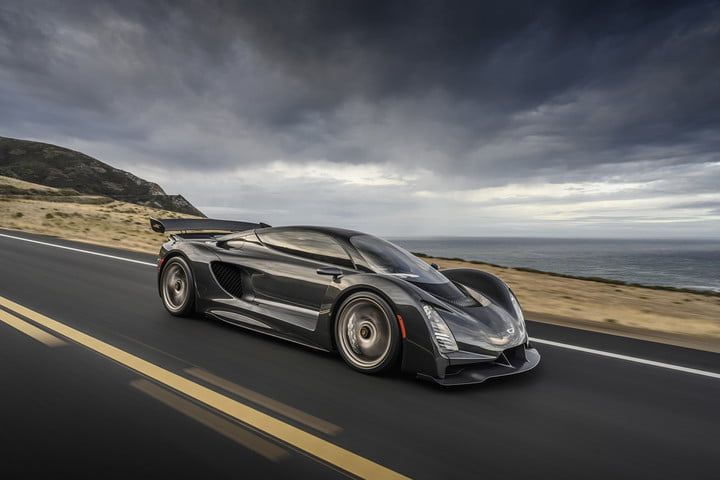Divergent Adaptive Production System (DAPS) developer Divergent Technologies has announced the closure of a $160 million Series C funding round.
Utilizing DAPS, an automated automotive assembly platform that combines 3D printing with generative design, Divergent has already committed to build the 1,233 bhp 21C hypercar for sister firm Czinger, which ships next year. According to the company, its newly-raised funding should now allow it to industrialize DAPS, while “expanding its operations,” to meet “growing demand among automotive OEMs.”
“The long-term potential for Divergent’s digital manufacturing technology is revolutionary across multiple industries, not just automotive,” said David Beirne, a General Partner at Benchmark Capital and Divergent board member. “Its proprietary DAPS system is so adaptable that you could build just about anything efficiently without requiring massive capital investment and a large industrial footprint.”
“Divergent is a game-changer for American manufacturing.”

Divergent’s Adaptive Production System
Over the last eight years, Divergent has managed to hone its DAPS system, and turn it into a complete, end-to-end modular car-building platform. Designed to serve as a fully-fledged alternative to traditional automotive production processes, the software-hardware solution has allowed the firm to become a Tier 1 automotive supplier, and it now provides chassis and suspension systems to major OEMs.
When it comes to 3D printing, the technology’s integration into DAPS provides it with the flexibility to manufacture vehicles with varying specifications on the same system, and effectively make it ‘model agnostic.’ The rapid iteration unlocked via additive manufacturing also enables the system to computationally engineer parts on-the-fly, before producing and assembling them without manual configuration.
However, while DAPS’ employment of 3D printing is said to result in less wasteful and more economical automotive builds, Divergent’s Founder Kevin Czinger explained ahead of his keynote speech at AMUG 2022, that the technology is only one element of a process that represents a leap “from the Selectric typewriter to a Mac desktop.”
“We didn’t adopt 3D printing, we started with a clean sheet approach to digital manufacturing as a system,” claimed Czinger. “We looked at the capital, material, energy inefficiency and design constraints of existing analog auto-manufacturing, and architected and built a full end-to-end digital manufacturing system, of which additive manufacturing is one of the integrated sub-systems.”
Investing in DAPS’ industrialization
Having wrapped up its Series C funding round, Divergent has now raised around $200 million to date, with previous investors including Horizons Ventures and Altran Technologies. On this occasion, backers included the likes of US businessman Tom Steyer and long-term stakeholder John L. Thornton, the latter of which is a Ford board member.
As part of the financing deal, Thornton is set to join Czinger’s board of directors, a position from which he can potentially draw on his automotive experience, to guide DAPS’ ongoing industrialization. Steyer, meanwhile, believes that given its sustainability advantages over traditional manufacturing processes, DAPS’ expansion could help fast-track the adoption of Zero Emission Vehicles (ZEVs).
“By greatly reducing the carbon emissions and the industrial footprint of automotive manufacturing, Divergent is one of the companies I’m most hopeful will have an important impact on our ability to combat climate change,” said Series C Divergent investor Steyer. “ZEVs are an important part of a greener future, but if we can’t reduce the environmental costs of building them in the first place, their impact will never be fully realized. Divergent’s technology can change that.”
Czinger’s record-breaking hypercar
In the past, Divergent has partnered with SLM Solutions to scale its platform’s capabilities and deployed it within a Shanghai EV production plant, but DAPS’ highest profile application to date is no doubt the ‘21C.’ Developed by Czinger’s other business, Czinger Vehicles, the upcoming hypercar is driven by two electric motors and a 2.88 liter V8, enabling it to go from 0-62 mph in 1.9 seconds.
As opposed to traditional automotive manufacturers, which tend only to use 3D printing in the creation of non-critical parts such as interior trim, Czinger Vehicles has deployed it to produce structural elements of the 21C. In fact, the vehicle is said to feature multiple SLM Solutions-3D printed parts, including an Inconel exhaust system and windshield binder that are robust enough for high-speed deployment.
With the 21C’s release window coming up fast, Czinger Vehicles sent it for testing at the Laguna Seca Raceway last year, where it’s reported to have broken the production car lap record by a ‘considerable margin.’ Next up for the $2 million hypercar is a debut at the Goodwood Festival of Speed, scheduled to take place from 23-26 June, 2022, ahead of its delivery to customers, which is slated for 2023.
To stay up to date with the latest 3D printing news, don’t forget to subscribe to the 3D Printing Industry newsletter or follow us on Twitter or liking our page on Facebook.
For a deeper dive into additive manufacturing, you can now subscribe to our Youtube channel, featuring discussion, debriefs, and shots of 3D printing in-action.
Are you looking for a job in the additive manufacturing industry? Visit 3D Printing Jobs for a selection of roles in the industry.
Featured image shows the DAPS-built Czinger 21C. Photo via Czinger.
